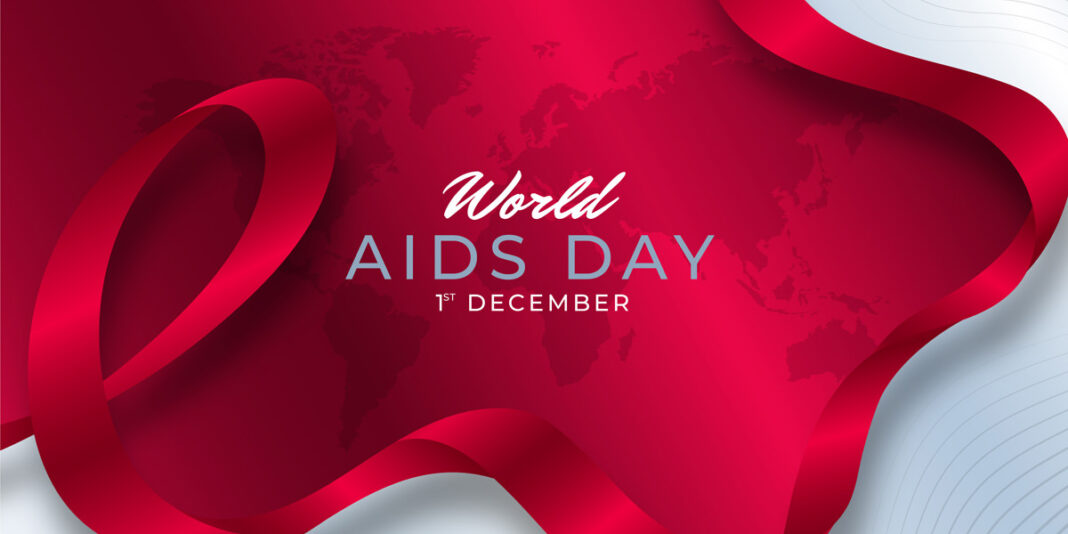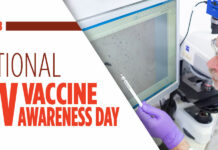It has now been 42 years since the first AIDS cases reported in the United States and this year commemorates the 35th event. World AIDS Day began in 1988 and has taken place on December 1 each year since to provide awareness about HIV/AIDS and to honour the lives of those affected by the epidemic. Each year a new theme is adopted, with the UNAIDS theme for 2023 being “Let Communities Lead“, with other themes around the world being “Remember and Commit” in the United States, “Rock the Ribbon” in the United Kingdom and “Inclusion. Respect. Equity.” in Australia.
The red ribbon is the most iconic symbol associated with HIV/AIDS campaigns and is widely recognised throughout the world. The ribbon was created in 1991 by a group of artists who gathered in New York City to discuss a project for Visual AIDS, which is a New York HIV-awareness arts organisation. The artists wanted to create a visual expression of compassion for people living with HIV at a time when the virus was highly stigmatised and people around the world were quick to embrace the symbol. Even though HIV/AIDS highly impacts the LGBTIQA+ community, the designers chose the colour red, rather than the rainbow pride colours, because they wanted to convey that HIV is relevant to everyone, with red being a colour that is bold and has associations with passion, the heart and love.
This disease is resilient and resourceful, ever mutating to escape destruction.
Congresswoman Nancy Pelosi, World AIDS Day 2019.
Each year UNAIDS releases their Global HIV and AIDS Statistics Fact Sheet, which shows that 39.0 million people globally were living with HIV in 2022. When we delve further into the numbers, there’s a massive number of people who have been infected with HIV and estimates show that there have been over 40.4 million deaths from AIDS since the epidemic began in the 1980s. Not only is this a huge number of people who have directly died from AIDS, but the deaths of so many has also affected the lives of many others, including partner’s, relatives, family and friends.
This is why World AIDS Day is such an important day on the calendar, because not only does this event acknowledge the achievements that have been made to help those of us who have been infected with HIV/AIDS to live a life that’s comparable to someone who has not been infected with the virus, but also to remember those who have passed away as a result of the virus, because many of these people who passed away were not afforded the opportunity most of us have today to be able to take antiretroviral medication, should we choose to. Below is the latest data so you can see the changes that have taken place over the past few years.
| GLOBAL HIV DATA | 2020 | 2021 | 2022 |
|---|---|---|---|
| People currently living with HIV | 37,700,000 | 38,700,000 | 39,000,000 |
| Total number of people infected with HIV since the beginning of the epidemic | 79,300,000 | 84,200,000 | 85,600,000 |
| New HIV infections (people aged 15+ years) | 1,500,000 | 1,300,000 | 1,200,000 |
| AIDS-related deaths | 680,000 | 660,000 | 630,000 |
| Total number of AIDS-related deaths since the beginning of the epidemic | 36,300,000 | 40,100,000 | 40,400,000 |
| People currently accessing antiretroviral therapy | 27,500,000 | 28,700,000 | 29,800,000 |
There have been some reports of an increase in the number of new HIV infections around the world and as an example, data from the United States has been provided in this article to give some insight into the situation that is taking place there. The latest available data for the United States is from 2021, so according to the Centers for Disease Control and Prevention (CDC), the number of new HIV diagnoses increased 18% from 30,585 in 2020 to 36,136 in 2021, with the 2021 figure being similar to the 2019 figure of 36,845. This sharp decrease in 2020 cases appears to be the result of the impact caused by the COVID-19 pandemic reducing access to HIV/AIDS services, so it might take us another year for the data to return to a level where a more accurate comparison can be made.
The CDC data indicates that 79% of new HIV diagnoses involved men at 79% (28,620 cases), with 67% (24,107 cases) involving male-to-male sexual contact, compared to 22% (8,059 cases) involving heterosexual contact. New diagnoses involving injection drug use came in at 7% (1,375 cases), with a combination of male-to-male sexual contact and injection drug use coming in at 4% (1,375 cases). The largest number of new HIV infections in the United States affects the Black/African American race at 40% (14,528 cases), followed by the Hispanic/Latino race at 29% (10,467 cases), then the White race at 25% (9,063 cases). Most new HIV infections in the United States involved people aged 25 to 34 at 37% (13,204 cases), followed by those aged 35 to 44 at 21% (7,634 cases), then those aged 13 to 24 at 19% (6,987 cases). More than 52% (18,703 cases) of new HIV infections took place in the South of the country.
UNITED STATES HIV DATA
New HIV Diagnoses
| 2017 | 2018 | 2019 | 2020 | 2021 |
|---|---|---|---|---|
| 38,791 | 37,762 | 36,845 | 30,585 | 36,136 |
It has been reported that there has been new HIV infection increases in other countries as well, with England reporting an increase in the number of new HIV diagnoses first made in England of 6% based on 2,444 new infections in 2022, compared to 2,313 in the previous year. This may also be the result of the COVID-19 pandemic skewing the data, although these new infections took place in 2022, which is being compared to the 2021 data, with the 2020 data being the main issue with COVID-19 skewing the data. According to AIDSinfo, there have also been some increases in newly infected cases for a number of African countries, along with Brazil, Chile, Indonesia, Papua New Guinea and the Philippines.
There are various AIDS memorials and museums around the world and in Australia, there is the AIDS Garden of Reflection, which is a living tribute to those who we have lost to AIDS and the garden is also in support of those living with HIV. The garden was opened in 2017 and is designed as a place of contemplation and for families and friends to honour those we have lost to HIV/AIDS. There may be other gardens around the world with a similar concept or places where we can also reflect on those who have passed away on this important day.
You can support World AIDS Day by looking up some of your local HIV/AIDS organisations and getting involved in various ways, some which are not monetary. Many HIV/AIDS organisations provide various forms of assistance to those who are affected by HIV/AIDS and without our support, the assistance they are able to provide is limited. When it comes to World AIDS Day, have a think about what it means to you, whether it be you are grateful for the advancements in research and healthcare, the increase in knowing about HIV/AIDS to reduce stigma, to remember and honour those who have passed away or a combination of these reasons.
References and Further Reading:
- AIDSinfo
- Global HIV & AIDS Statistics Fact Sheet
- HIV and AIDS
- Let Communities Lead
- Rock the Ribbon
- World AIDS Day 35: Remember and Commit
Featured Photo: Image by Freepik
Article ID: CC073
Version Control: 1.0 – December 1, 2023: Original article published.








Good read. I agree with PositiveOutlook that December 1st definitely has many different meanings to those living with HIV/AIDS and those who are support and caregivers, including family. I know personally, for many of my early years after being diagnosed, I spent that day in a very different environment.
Jason once again a stellar job my friend. Thanks for a well-done article. Some of the stats are a bit disturbing, but given the human challenges emerging globally, understandable.
Thanks Jim. I was interested in the data this year, as some of the data is returning to normal levels after COVID-19 impacted the reporting and data based on access to services and you’re right, some of the stats are a bit disturbing, so I will be interested to see how things look next year when the data returns to more normal levels to see if there is a continued uptick in cases or whether things have stabilised.
Great summary of a very complex data set as well as a terrific write-up of how December 1 means different things to different folks here. Much appreciated, Jason!
This is such an important day on the calendar and it’s also a great opportunity to share the data that gets released so we can see the big picture of HIV/AIDS around the world. December 1 will mean different things to different people and it’s a day that brings people together through HIV/AIDS in different ways. Thank you for your kind words about this article too, I really appreciate it.
Thank you again @Jason for well written and well researched article. Although some of us choose this day to recommit ourselves to our pursuit of the virus, it is also a time to remember those who came before us, those who maybe did not seek out this “gift”and yet received it and the honor and bravery with which many of them died despite the scorn and disrespect they received and the inadequate treatment they often received.Let us make sure none of us are subject to that.
Thank you Tom and I appreciate your kind comments regarding this article. Today does mean different things to each of us, so this day is an opportunity to reflect or to think more about HIV/AIDS and you’re right, some of us are going to use this date on the calendar as a day of reaffirming what we’re wanting to achieve or should I say receive. You have mentioned something really important, which is that today is also an opportunity for us to be able to honour those of us who passed away and to also remember that many people who did pass away, were not bug chasers and simply acquired HIV and developed AIDS unintentionally.